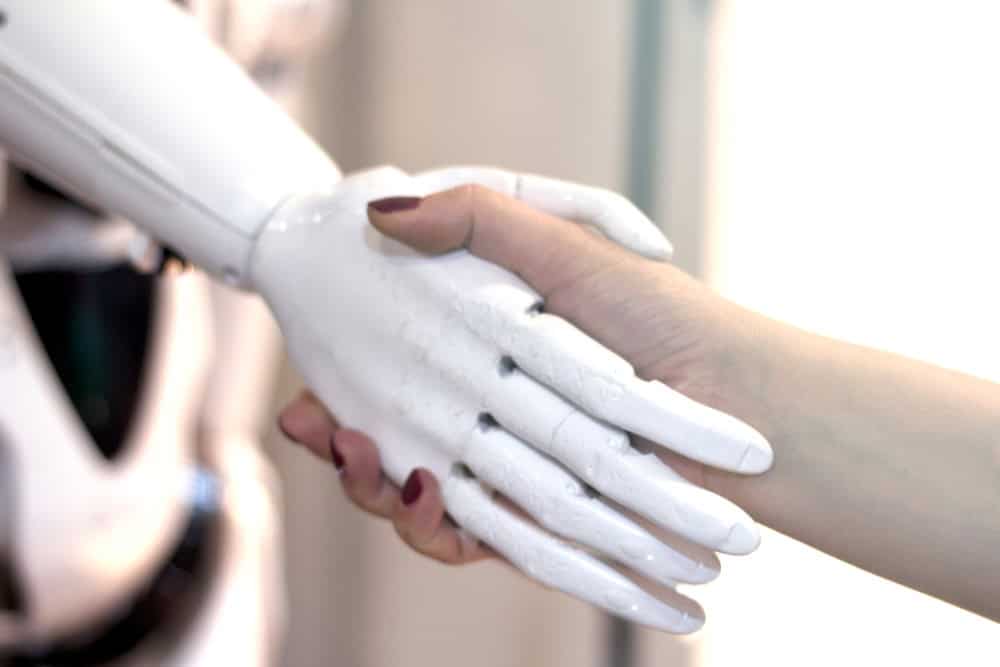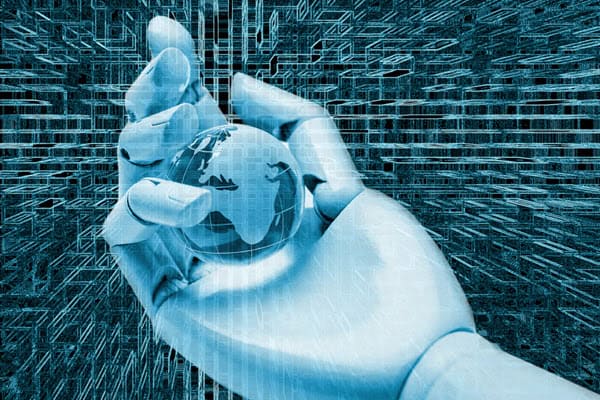In a world where technology evolves faster than our morning coffee cools down, the HR world isn’t immune to the ripples of change.
Understandably, many HR leaders and practitioners are experiencing “AI anxiety”—that nagging feeling that robots might swipe our jobs and eat all our office snacks. But before we start writing the new HR Terminator movie, let’s breathe for a moment.
Think of the current scenario as a horse-and-buggy driver suddenly finding himself in a Tesla showroom. Overwhelming? Sure. Exciting? Absolutely!
A Brief History of AI in Business

The journey of AI in business includes twists, turns, and infinite drama. We started with simple algorithms and have now reached the realms of machine learning that would make sci-fi authors blush.
Remember the days when ‘AI’ was just a fancy term thrown around in tech conferences? Fast forward to today, and it’s the backbone of many industries. From finance to healthcare, AI has left its mark.
The initial skepticism was intense. Many viewed AI as just another tech fad destined to fade away. But as industries began to see its transformative power, the skepticism turned to awe. Companies that once relied on traditional methods started to see the potential of AI, leading to its widespread adoption.
Today, Johnny Cab, the robot taxi driver from the movie Total Recall, is ready to pick you up curbside (called Waymo and Cruise). And Amazon Prime knows what you want to buy before you do!
The Rise of AI in HR
Driverless cars are fun, but isn’t the HR department supposed to be the human side of organizations?
In short, yes. Embracing the human side means taking great care of a company’s employees. And recently, that has required digital transformation to keep up with the ever-increasing digital world in which our employees live.
They binge-watch recommended shows on Netflix, communicate as much or more via text than they speak to others, place mobile orders for Starbucks, and even have groceries and food delivered from Grubhub and Instacart.
Asking them to fill out a paper HR form is like handing them a hammer and chisel to complete their stone-tablet W4. And if this feels like an exaggeration, think about how many times you have picked up a pen or pencil in the last 30 days. Handwriting is a dying art.
AI to the rescue! With its promise of efficiency and accuracy, AI began with simple tools to streamline HR processes. Over time, these tools evolved, becoming more sophisticated and integral to HR functions.
Companies like Microsoft and Tesla have crafted success stories, integrating AI seamlessly into HR processes. These aren’t isolated examples.
From startups to Fortune 500 companies, AI’s footprint in HR is evident. And it’s not just about efficiency. AI tools today can gauge employee sentiments, predict turnover rates, and even assist in crafting employee wellness programs.
Modern AI can analyze employee sentiments in real-time – quite an advancement from the first AI tools that probably couldn’t differentiate between a resume and a grocery list.
Companies aren’t just adopting AI in HR but thriving with it.
Common Myths and Misconceptions about AI in HR
Every technological or cultural revolution arrives with a busload full of hitchhiking myths. And the AI revolution in HR is no exception. These hitchhikers, often born from misunderstandings or fear of the unknown, hinder progress and innovation.
Let’s kick a few of them off the progress bus.
Myth 1: AI will replace all HR jobs

Reality check: AI is a tool, not a replacement.
While it’s true that AI can automate specific tasks, human elements, such as empathy, intuition, and understanding, are irreplaceable.
Think of AI as a helpful assistant, always there to lend a hand but never taking the lead.
Myth 2: AI lacks the ‘human touch.’

Well, that’s like saying a calculator lacks emotion. It’s not supposed to have any; it’s here to calculate!
AI is designed to process data and provide insights.
It’s still up to a human to interpret, understand, and act on those insights.
Myth 3: Implementing AI is like climbing Everest

Not quite. With the proper guidance, tools, and mindset, it’s more like a hill than a mountain. Of course, there will be challenges along the way, but the view from the top is worth it.
Many real-world examples exist to debunk these myths. Companies like IBM, Google, and Amazon have integrated AI into their HR processes, enhancing rather than replacing them.
Though many HRAI initiatives are in the beginning stages, the early results show that the myths have to find new places to hitchhike.
Benefits of Embracing AI in HR
There are more perks to integrating AI in HR than drink order combinations at Starbucks (even during pumpkin spice season).
- Automation: New, automated processes reduce manual tasks to a minimum, eliminating task friction for everyone.
- Efficiency: No more sifting through resumes or keying (or re-keying) data. With AI, these tasks are streamlined, freeing time for more strategic initiatives.
- Data-driven decisions: Gut decisions are often wrong. AI provides insights to guide important decisions for hiring, performance evaluations, and more, all backed by solid, data-driven analytics.
- Enhanced employee experience: AI can personalize the employee experience, ensuring employees receive training, knowledge, and tools tailored to their success needs.
- Global competitive edge: On the global stage, AI-equipped companies are competitively sharper than their stone-age rivals. They quickly predict trends, adapt to market changes, and stay well ahead of the competition.
Actionable Tips for HR Leaders to Incorporate AI
Ready to dip your toes into the AI waters? Here’s a roadmap for your journey:
- Recruitment: AI-powered tools can screen candidates faster than you can say, “You’re hired!” They can analyze resumes, match qualifications to job requirements, and even predict a candidate’s potential success in a role.There are rules to prevent bias and discrimination, so check with your recruiting technology vendor to ensure your solution is as compliant as it is effective.
- Employee Engagement: Chatbots are the new suggestion boxes. They can answer real-time employee queries, gather feedback, and provide instant support. It’s hard to beat a well-trained AI chatbot for the first few tiers of employee support.
- Training & Development: AI-driven platforms offer personalized learning, making generic training modules a thing of the past. These platforms can identify an employee’s strengths and weaknesses, creating a tailored training program to address them. And AI can analyze your current training modules for gaps or inconsistencies.
- Data Management: AI tools can sort and analyze data with the efficiency of a librarian on a mission. They can identify trends, predict potential issues, and provide real-time insights to guide HR strategies.
- Feedback & Surveys: AI doesn’t just collect feedback; it offers actionable insights. It can analyze survey results, identify areas of concern, and provide recommendations for improvement.
- Communications: AI can assist with employee communications by analyzing data and feedback to personalize messages, ensure clear and effective communication, and automate delivery.
- Collaboration: Two heads are better than one. Partner with IT teams to find the best AI tools tailored to your needs. They can provide insights into the latest technologies, ensuring you have the best tools for the job.
- Continuous Learning: The AI landscape is ever-evolving. Stay updated, stay relevant. Attend workshops, webinars, and conferences. Network with industry leaders and stay informed about the latest trends and tools in HR.
AI Tools Every HR Should Know About
The AI toolbox for HR is brimming with gadgets, each designed to address specific challenges. Recruitment bots, for instance, are revolutionizing the hiring process. But it doesn’t stop there.
Analytics tools provide insights into employee performance that were once hidden. These tools track KPIs, monitor progress, and even predict future performance trends.
Workforce planning tools take the guesswork out of demand modeling and ensure companies know when and where to deploy their most valuable resource – their employees.
Compensation analysis is easier than ever with AI features that use current data to analyze market trends and provide unemotional recommendations for compensation, bonuses, and benefits aimed at remaining fair and competitive.
Modern, AI-driven platforms now act as digital coaches and mentors for employees, offering data-informed coaching sessions, performance feedback, and tailored development resources to help employees reach their potential.
And let’s not forget virtual onboarding platforms. Remember the first-day jitters? The overwhelming feeling of being the ‘new kid’? Virtual onboarding platforms are designed to ease this transition, making the first day less about paperwork and more about integration. They offer interactive modules, virtual tours, and even AI-driven mentors to guide new employees.
The Future of HR with AI
Fast forward a decade, and the HR department looks more futuristic than ever.
Total Recall showed life on Mars in 2084, yet Waymo brought Johnny Cab to life 60 years earlier.
So what’s the HR equivalent of Johnny Cab?

Predictions hint at an even greater synergy between human intuition and AI insights. We’re looking at AI tools that can not just analyze data but also understand it.
Imagine an AI tool that can gauge the office’s mood, offering insights into employee well-being. The blend of human intuition and AI will be the cornerstone of future HR practices. And while we might occasionally reminisce about the ‘good old days’ of manual HR, the future is bright, efficient, and AI-driven.
The essence of HR is still human connection. AI will enhance this connection, not replace it.
HR once shifted from “Personnel” to “Human Resources.” Then, HR became a strategic partner rather than just a compliance enforcement department. Now, it’s time for HR professionals to embrace this next change – harnessing the power of AI to craft a brighter, more efficient future.
The journey has already begun, whether you’re on it or not. Change is the only constant. So, why not make it an AI-powered one?

